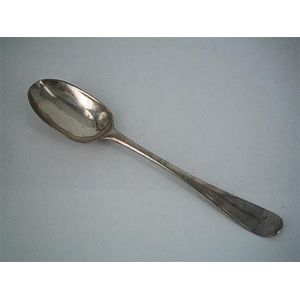Victorian Sterling Silver Sugar Sifter Spoon Chawner & Co
You must be a subscriber, and be logged in to view price and dealer details.
Subscribe Now to view actual auction price for this item
When you subscribe, you have the option of setting the currency in which to display prices to $Au, $US, $NZ or Stg.
- Chasing - The method of decorating gold and silver objects using a punch and hammer so that the design appears in relief. Flat or surface chasing is done from the front giving the item definition, but not cutting into the metal.
Chasing is the opposite technique to repousse, but an object that has repousse work, may then have chasing applied to create a finished piece. - Marrow Spoon - A spoon with a long handle and a narrow scoop shaped bowl, used to scoop and eat marrow from the hollow centre of roasted bones. Some marrow scoops are double ended with a different shaped bowl at each end.
- Sterling Silver - Sterling silver is a mixture of 92.5% pure silver and 7.5% of another metal, usually copper. Fine silver is 99.9% pure silver, and is relatively soft and the addition of the very small amount of copper gives the metal enough strength and hardness to be worked into jewellery, decorative and household objects.
- Victorian Period - The Victorian period of furniture and decorative arts design covers the reign of Queen Victoria from 1837 to 1901. There was not one dominant style of furniture in the Victorian period. Designers used and modified many historical styles such as Gothic, Tudor, Elizabethan, English Rococo, Neoclassical and others, although use of some styles, such as English Rococo and Gothic tended to dominate the furniture manufacture of the period.
The Victorian period was preceded by the Regency and William IV periods, and followed by the Edwardian period, named for Edward VII (1841 ? 1910) who was King of the United Kingdom and the British Dominions and Emperor of India for the brief period from 1901 until his death in 1910.
This item has been included into following indexes:
Visually similar items

A George IV sterling silver Sifting spoon, 1828 London, with maker's mark for William Eaton, the 'Fiddle pattern' sifter with reeded edges to both sides with a shallow bowl pierced with a radiating design from a central flower, hallmarked underside to fini

An early Victorian silver sifter spoon, fiddle pattern, crested, with gilt, pierced bowl; Wm Eaton, London 1839

A Chinese silver sifter spoon, plain form, round bowl, c.1900. Hallmarked 06HM. Weight 43.5g.

An 18th century silver table spoon, Hanoverian pattern; maker's mark Im or Lm; not traced, c.1720.
